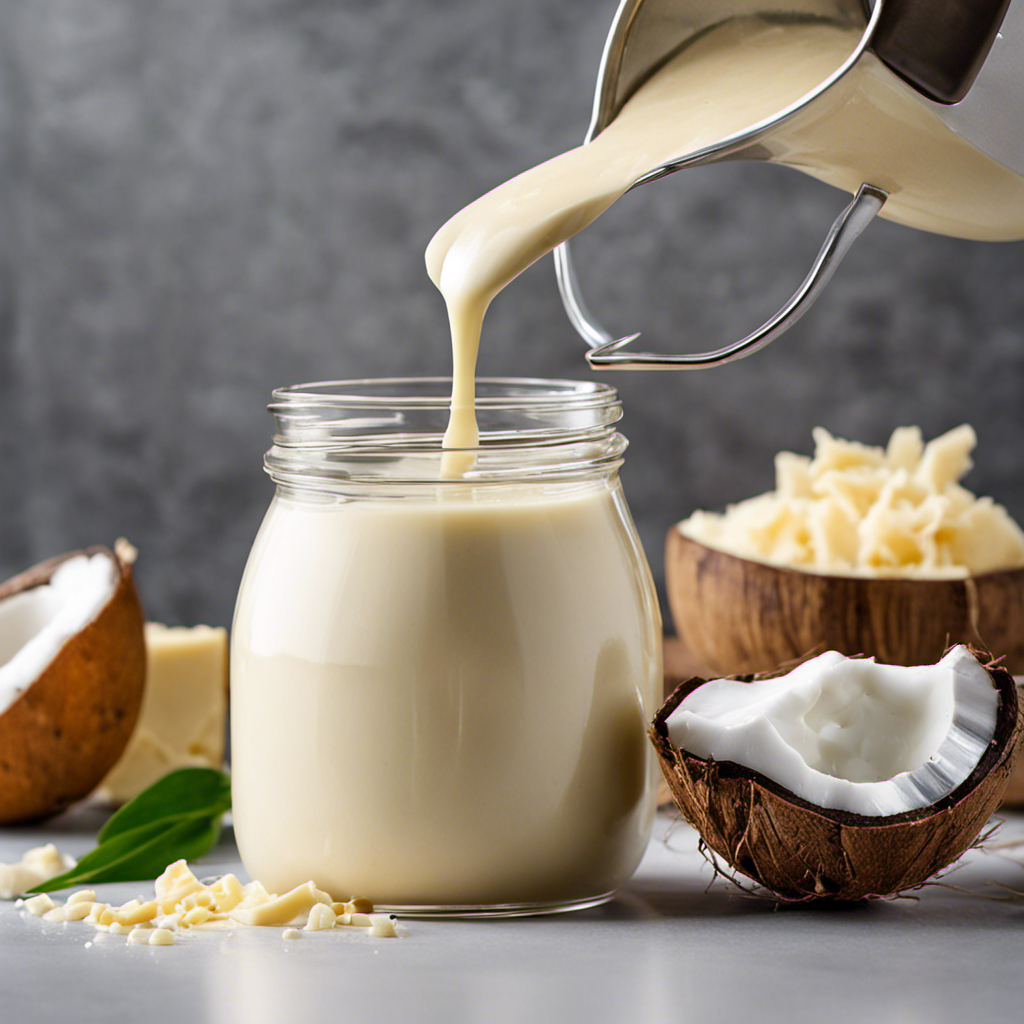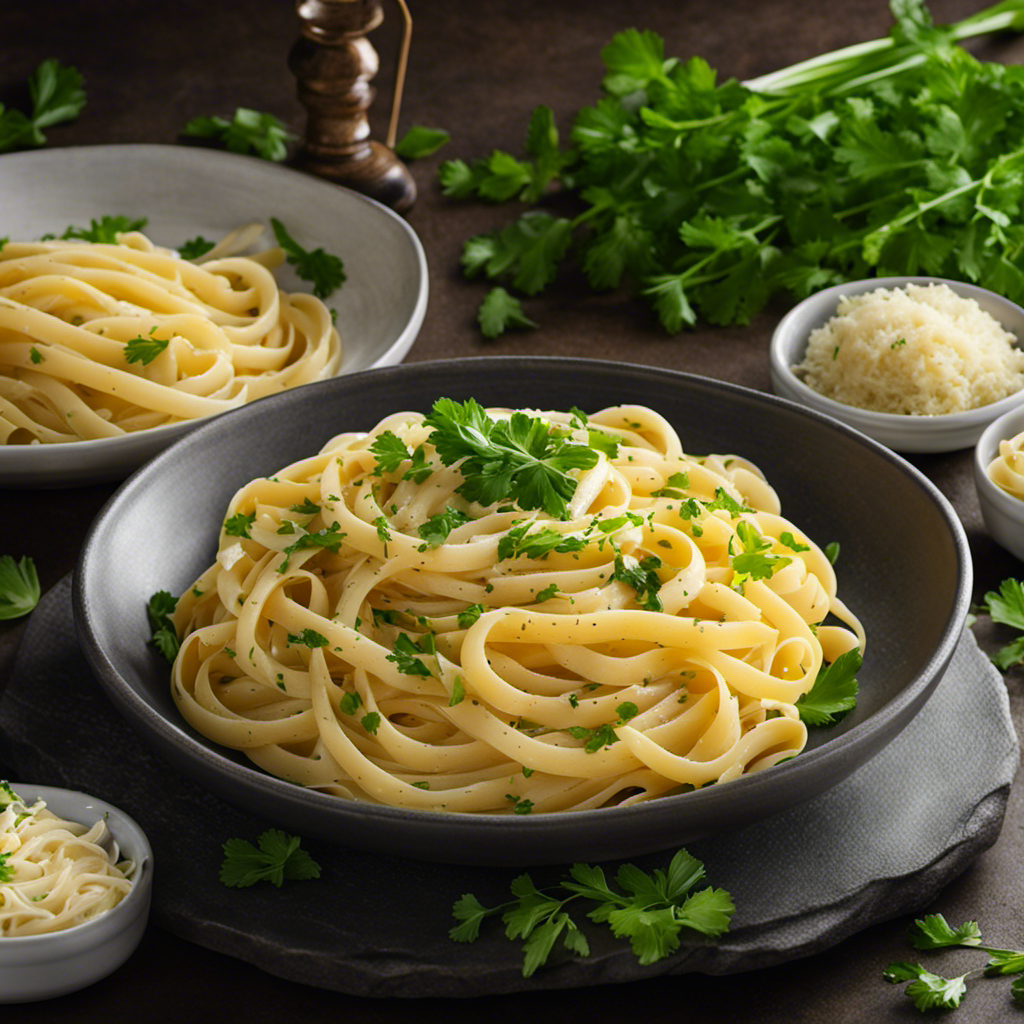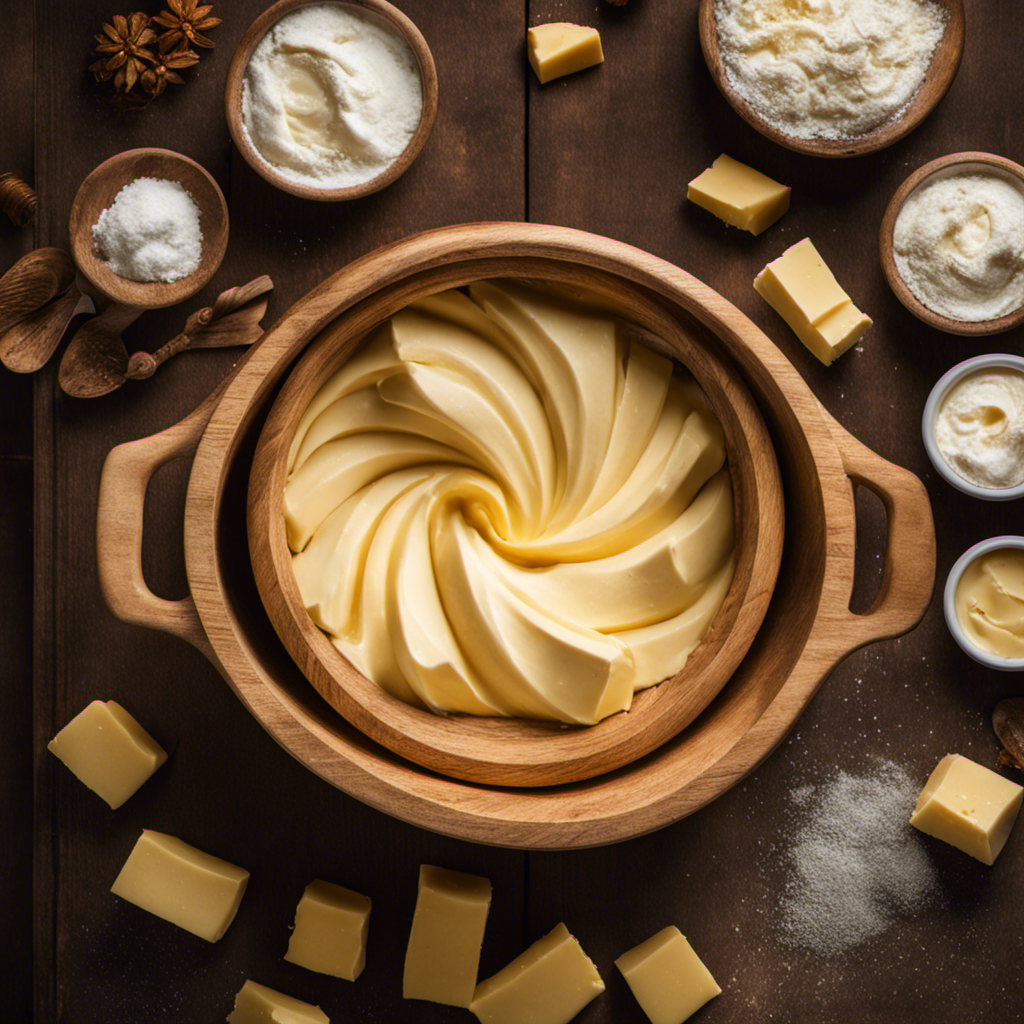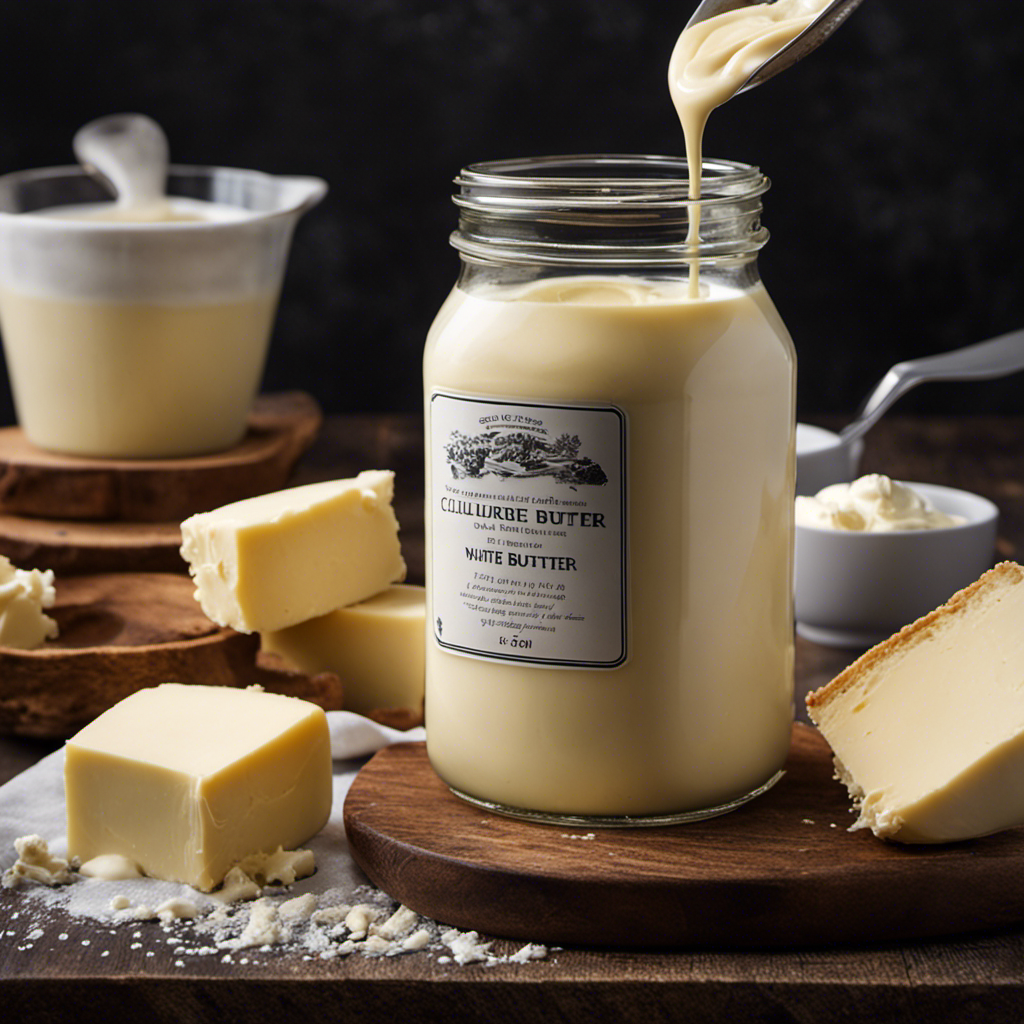I have always had a fondness for butter, however, I am unable to consume dairy. This led me to experiment and create my own dairy-free butter.
In this article, I’ll share with you my tried and tested recipe for making delicious dairy-free butter right in your own kitchen. With the right ingredients and a step-by-step process, you’ll be able to enjoy the creamy goodness of butter without any dairy.
So, let’s get started and discover the wonders of dairy-free butter together!
Key Takeaways
- Dairy-free butter is a suitable substitute for those who are lactose intolerant or follow a vegan diet.
- Dairy-free butter is made from plant-based oils like coconut or avocado, providing a rich and creamy texture.
- Plant-based oils in dairy-free butter are packed with healthy fats, like monounsaturated and polyunsaturated fats.
- Dairy-free butter is often fortified with essential nutrients like vitamin E and omega-3 fatty acids.
The Benefits of Dairy Free Butter
You’ll love the benefits of dairy-free butter. You can enjoy a creamy spread without any lactose or cholesterol. Dairy-free butter is a fantastic substitute for those who are lactose intolerant or following a vegan diet. It is made from plant-based oils, such as coconut or avocado, which provide a rich and creamy texture. These oils are also packed with healthy fats, like monounsaturated and polyunsaturated fats, which are beneficial for heart health.
Additionally, dairy-free butter is often fortified with vitamins and minerals. It provides essential nutrients like vitamin E and omega-3 fatty acids. It can be used in baking, cooking, or simply spread on toast. With its numerous benefits and delicious taste, dairy-free butter is a great option for those looking for a dairy-free alternative.
Choosing the Right Ingredients for Dairy Free Butter
When choosing ingredients for dairy-free butter, it’s important to consider the alternatives to traditional dairy products. Here are some key ingredient sources to keep in mind:
-
Plant-based oils: Options like coconut oil, avocado oil, and olive oil can provide a creamy texture and rich flavor to your dairy-free butter. These oils are also packed with healthy fats, which can be beneficial for your overall health.
-
Nut butters: Adding a scoop of almond butter or cashew butter can enhance the taste and add a nutty undertone to your dairy-free butter.
-
Emulsifiers: Ingredients like lecithin, found in soy or sunflower, can help stabilize the butter and prevent separation.
When troubleshooting common issues, such as grainy texture or lack of spreadability, consider adjusting the ratios of the ingredients or experimenting with different brands. It may take some trial and error to find the perfect combination for your dairy-free butter, but with patience and persistence, you can create a delicious and satisfying alternative to traditional butter.
Step-by-Step Process for Making Dairy Free Butter
To start, gather all the necessary ingredients for your homemade alternative to traditional butter. Here is a step-by-step process for making dairy-free butter that you can enjoy guilt-free.
Firstly, you’ll need a base ingredient like coconut oil or vegan margarine. These options provide a creamy texture and a buttery taste. Next, add a liquid such as almond milk or soy milk to give your dairy-free butter a smooth consistency. To enhance the flavor, you can include a pinch of salt and a squeeze of lemon juice. Lastly, you can customize your butter by adding herbs, spices, or even nutritional yeast for a cheesy flavor.
| Ingredients | Measurements |
|---|---|
| Base Ingredient | 1 cup |
| Liquid | 1/4 cup |
| Salt | 1/2 teaspoon |
| Lemon Juice | 1 teaspoon |
| Optional | as desired |
Once you have gathered all the ingredients, follow the instructions provided in the subsequent section to perfect your dairy-free butter recipe.
Tips and Tricks for Perfecting Your Dairy Free Butter Recipe
When it comes to making dairy-free butter, there are a few key factors to consider for a successful recipe.
First, finding suitable ingredient substitutions for dairy is crucial. Whether it’s using plant-based milks or alternative fats, these substitutions can greatly affect the taste and texture of your butter.
Additionally, achieving a creamy texture is essential for a butter-like consistency. Exploring different techniques and ingredients, such as coconut oil or avocado, can help you achieve that desired creamy texture.
Lastly, flavor enhancements and variations can take your dairy-free butter to the next level. Experimenting with herbs, spices, or even adding a touch of sweetness can create a unique and flavorful butter substitute.
Ingredient Substitutions for Dairy
You can easily substitute dairy products with plant-based alternatives in your recipe for dairy-free butter. When it comes to vegan baking or plant-based cooking, there are plenty of options to choose from. Here are some ingredient substitutions to help you create a delicious and creamy dairy-free butter:
-
Base Ingredients:
-
Coconut oil: adds richness and a smooth texture to your dairy-free butter.
-
Nut or seed butter: provides a creamy consistency and adds a nutty flavor.
-
Flavor Enhancers:
-
Nutritional yeast: adds a cheesy flavor to your dairy-free butter.
-
Lemon juice or apple cider vinegar: adds a tangy taste to mimic the flavor of dairy.
Achieving a Creamy Texture
If you want a creamy texture in your plant-based alternative, try using coconut oil or nut/seed butter as the base ingredients. These ingredients are rich in fats, which helps in achieving a smooth consistency. However, there are some common texture issues that can arise when making dairy-free butter. To troubleshoot these issues, it’s important to consider factors such as temperature, blending time, and the type of blender or food processor used. Below is a table that provides a visual representation of these troubleshooting tips:
| Texture Issue | Possible Solution |
|---|---|
| Grainy texture | Increase blending time or add a liquid such as plant-based milk |
| Separation | Use an emulsifier such as lecithin or soy protein isolate |
| Too stiff | Add more liquid or soften the butter before use |
| Watery | Reduce the amount of liquid or add more solid ingredients |
Flavor Enhancements and Variations
Adding different herbs and spices can help enhance the flavor and create unique variations in your plant-based alternative. When it comes to flavor pairings, there are endless possibilities to explore in dairy-free butter recipes.
Here are some ideas to get you started:
-
Sweet and Savory:
-
Cinnamon and nutmeg for a warm and comforting taste.
-
Rosemary and thyme for a savory and earthy profile.
-
Zesty and Tangy:
-
Lemon zest and dill for a refreshing and citrusy kick.
-
Garlic and paprika for a bold and tangy combination.
By experimenting with different herbs and spices, you can customize your dairy-free butter to suit your taste preferences. Remember to start with small amounts and gradually add more until you achieve your desired flavor.
Creative Ways to Use Dairy Free Butter in Your Cooking
When it comes to dairy-free alternatives, there are plenty of options available that can still provide flavor and texture to your dishes.
In this discussion, we will explore the world of flavorful vegan spreads, which can be used as a delicious substitute for traditional dairy spreads.
Additionally, we will delve into the art of baking without dairy, sharing tips and tricks to help you achieve the same tasty results.
Lastly, we will explore healthier dairy-free alternatives that can be incorporated into your diet, providing both nutrition and satisfaction.
Flavorful Vegan Spreads
There’s nothing quite like the taste of flavorful vegan spreads when it comes to making dairy-free butter. These delicious alternatives to traditional dairy spreads offer a wide range of flavors and textures that can elevate any dish.
When I think of vegan butter alternatives, two sub-lists come to mind:
-
Creamy and smooth spreads:
- Cashew-based spreads: These spreads have a rich and velvety texture that mimics traditional butter perfectly. They are made from soaked cashews blended with water and a touch of salt.
- Coconut oil spreads: Coconut oil, when solidified, can be used as a butter substitute. It adds a hint of coconut flavor and creates a smooth and creamy consistency.
-
Flavorful and tangy spreads:
- Nutritional yeast spreads: Nutritional yeast adds a cheesy and tangy flavor to spreads, making them a great choice for those looking for a savory option.
- Olive oil spreads: Olive oil can be whipped into a spreadable consistency, providing a delicious and slightly fruity taste.
These vegan butter alternatives and dairy-free spreads are not only tasty but also provide a healthier option for those following a plant-based diet or dealing with lactose intolerance.
Now, let’s explore how to use these flavorful spreads in baking without dairy.
Baking Without Dairy
Now that we have explored flavorful vegan spreads, let’s dive into the world of baking without dairy.
Baking can be a challenge when you’re trying to avoid dairy products, but with the right techniques and recipes, you can still enjoy delicious treats.
One important aspect of dairy-free baking is finding suitable substitutes for butter, milk, and cream. There are many dairy-free alternatives available, such as plant-based margarine or coconut oil for butter, almond milk or soy milk for milk, and coconut cream or cashew cream for heavy cream.
When it comes to baking, it’s important to follow the recipe closely and make any necessary adjustments for the dairy-free substitutes. Some recipes may require additional moisture or binding agents, so be sure to read the instructions carefully.
Fortunately, there are countless dairy-free recipes available online and in cookbooks that are specifically designed for those with dietary restrictions. These recipes have been tested and perfected to ensure that you can still enjoy the same delicious baked goods without compromising on taste or texture.
Healthier Dairy-Free Alternatives
Finding suitable substitutes for butter is essential when exploring healthier dairy-free alternatives. Plant-based margarine and coconut oil are two popular options.
Plant-based margarine is made from oils like canola, olive, or sunflower. It provides a creamy texture and a rich flavor. Compared to butter, it contains no cholesterol and is lower in saturated fat.
Coconut oil, on the other hand, is extracted from the meat of coconuts. It has a smooth consistency and a subtle coconut flavor. It contains medium-chain triglycerides, which are easily metabolized by the body and may provide various health benefits.
Storing and Shelf Life of Dairy Free Butter
When properly stored, dairy-free butter can maintain its quality and freshness for an extended period of time. Here are some storing tips to help you extend the shelf life of your dairy-free butter.
Firstly, it is important to keep the butter in an airtight container or wrap it tightly in aluminum foil or plastic wrap to prevent air exposure. This will help to prevent oxidation and maintain the flavor and texture.
Secondly, store the butter in the refrigerator at a temperature between 32-40°F (0-4°C). This will slow down the growth of bacteria and maintain its freshness.
Lastly, avoid storing the butter near strong-smelling foods as they can transfer odors.
Frequently Asked Questions
Can I Use Any Type of Oil to Make Dairy Free Butter?
Yes, you can use different types of oil to make dairy free butter. Each oil has its own pros and cons, such as taste and texture. It’s important to choose an oil that suits your preferences and dietary needs.
How Long Does It Take to Make Dairy Free Butter From Start to Finish?
Making dairy free butter is a simple process. With the right ingredients, it can be whipped up in no time. But, the exact duration depends on various factors such as the recipe and preparation method.
Can I Use Dairy Free Butter as a Substitute in All Baking Recipes?
Yes, dairy-free butter can be used as a substitute in most baking recipes. However, it’s important to consider the texture and taste differences. Experimenting with different dairy-free butter alternatives and following baking with dairy-free butter tips can help achieve the desired results.
Can I Use Dairy Free Butter for Frying or Sautéing?
Yes, you can use dairy free butter for frying or sautéing. It offers a great alternative for individuals with lactose intolerance or dairy allergies. It provides a similar taste and texture while being free from dairy.
Can I Freeze Dairy Free Butter for Later Use?
Yes, you can freeze dairy free butter for later use. It’s a convenient way to store it and ensure its freshness. Simply wrap it tightly in freezer-safe packaging and thaw when needed.
Conclusion
In conclusion, making dairy-free butter is a simple and rewarding process. It allows individuals with lactose intolerance or dietary preferences to enjoy the benefits of butter without the negative effects of dairy.
By carefully selecting the right ingredients and following the step-by-step process, you can create a delicious and versatile alternative. Whether you spread it on toast, use it in baking, or sauté with it, dairy-free butter adds a rich and creamy touch to your dishes.
So why not give it a try and ‘butter up’ your culinary adventures with this homemade delight?









